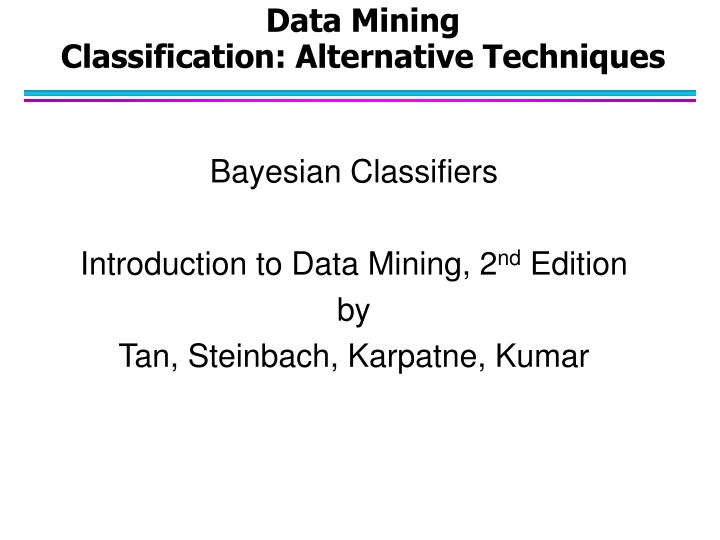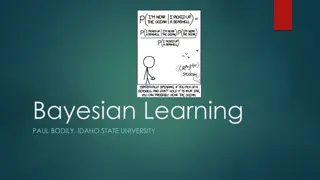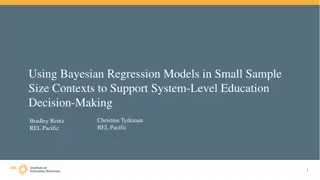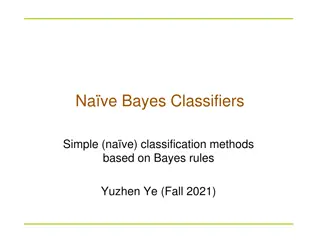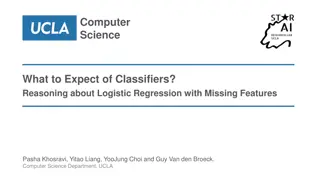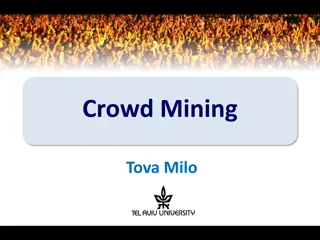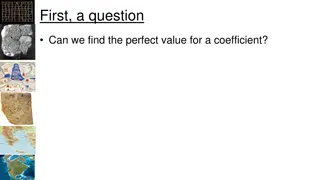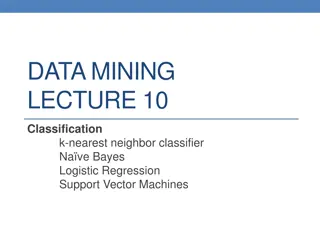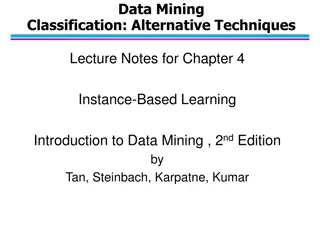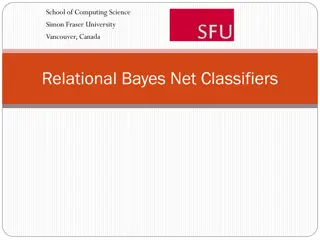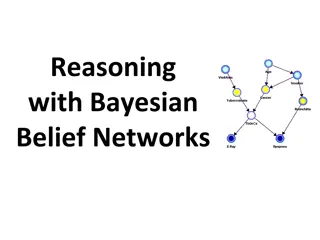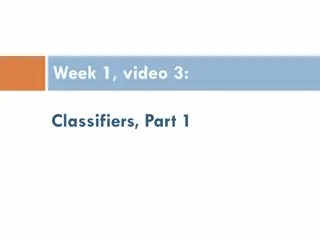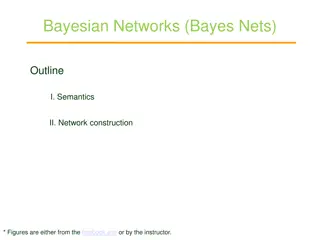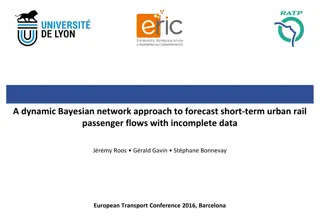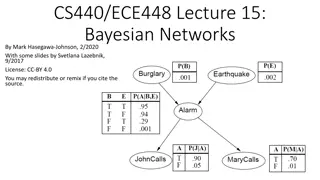Introduction to Bayesian Classifiers in Data Mining
Bayesian classifiers are a key technique in data mining for solving classification problems using probabilistic frameworks. This involves understanding conditional probability, Bayes' theorem, and applying these concepts to make predictions based on given data. The process involves estimating posterior probabilities to determine the most likely class for a given set of attributes. By using Bayes' theorem for classification, it becomes possible to make informed decisions based on data patterns and prior probabilities.
Download Presentation

Please find below an Image/Link to download the presentation.
The content on the website is provided AS IS for your information and personal use only. It may not be sold, licensed, or shared on other websites without obtaining consent from the author.If you encounter any issues during the download, it is possible that the publisher has removed the file from their server.
You are allowed to download the files provided on this website for personal or commercial use, subject to the condition that they are used lawfully. All files are the property of their respective owners.
The content on the website is provided AS IS for your information and personal use only. It may not be sold, licensed, or shared on other websites without obtaining consent from the author.
E N D
Presentation Transcript
Data Mining Classification: Alternative Techniques Bayesian Classifiers Introduction to Data Mining, 2nd Edition by Tan, Steinbach, Karpatne, Kumar
Bayes Classifier A probabilistic framework for solving classification problems Conditional Probability: ( P , ) P X Y = ( | ) P Y X ( X ) X ( P , ) P Y = ( | ) P X Y ( ) Y Bayes theorem: ( | ) ( ) P X Y P Y = ( | ) P Y X ( ) P X 02/14/2018 Introduction to Data Mining, 2nd Edition 2
Example of Bayes Theorem Given: A doctor knows that meningitis causes stiff neck 50% of the time Prior probability of any patient having meningitis is 1/50,000 Prior probability of any patient having stiff neck is 1/20 If a patient has stiff neck, what s the probability he/she has meningitis? / 1 ( | ) ( ) 5 . 0 50000 P S M P M = = = ( | ) 0002 . 0 P M S ( ) / 1 20 P S 02/14/2018 Introduction to Data Mining, 2nd Edition 3
Using Bayes Theorem for Classification Consider each attribute and class label as random variables Given a record with attributes (X1, X2, , Xd) Goal is to predict class Y Specifically, we want to find the value of Y that maximizes P(Y| X1, X2, , Xd ) Can we estimate P(Y| X1, X2, , Xd ) directly from data? 02/14/2018 Introduction to Data Mining, 2nd Edition 4
Example Data Given a Test Record: categorical categorical continuous = = = Refund ( No, Divorced, Income 120K) X class Can we estimate P(Evade = Yes | X) and P(Evade = No | X)? Tid Refund Marital Taxable Income Evade Status 1 Yes Single 125K No 2 No Married 100K No 3 No Single 70K No In the following we will replace Evade = Yes by Yes, and Evade = No by No 4 Yes Married 120K No 5 No Divorced 95K Yes 6 No Married 60K No 7 Yes Divorced 220K No 8 No Single 85K Yes 9 No Married 75K No 10 No Single 90K Yes 10 02/14/2018 Introduction to Data Mining, 2nd Edition 5
Using Bayes Theorem for Classification Approach: compute posterior probability P(Y | X1, X2, , Xd) using the Bayes theorem ( | ) ( ) P X X X Y P Y = ( | ) 1 P 2 X P Y X X X d 1 2 n ( ) X X 1 2 d Maximum a-posteriori: Choose Y that maximizes P(Y | X1, X2, , Xd) Equivalent to choosing value of Y that maximizes P(X1, X2, , Xd|Y) P(Y) How to estimate P(X1, X2, , Xd | Y )? 02/14/2018 Introduction to Data Mining, 2nd Edition 6
Example Data Given a Test Record: categorical categorical continuous = = = Refund ( No, Divorced, Income 120K) X class Tid Refund Marital Taxable Income Evade Status 1 Yes Single 125K No 2 No Married 100K No 3 No Single 70K No 4 Yes Married 120K No 5 No Divorced 95K Yes 6 No Married 60K No 7 Yes Divorced 220K No 8 No Single 85K Yes 9 No Married 75K No 10 No Single 90K Yes 10 02/14/2018 Introduction to Data Mining, 2nd Edition 7
Nave Bayes Classifier Assume independence among attributes Xi when class is given: P(X1, X2, , Xd |Yj) = P(X1| Yj) P(X2| Yj) P(Xd| Yj) Now we can estimate P(Xi| Yj) for all Xi and Yj combinations from the training data New point is classified to Yj if P(Yj) P(Xi| Yj) is maximal. 02/14/2018 Introduction to Data Mining, 2nd Edition 8
Conditional Independence l X and Y are conditionally independent given Z if P(X|YZ) = P(X|Z) l Example: Arm length and reading skills Young child has shorter arm length and limited reading skills, compared to adults If age is fixed, no apparent relationship between arm length and reading skills Arm length and reading skills are conditionally independent given age 02/14/2018 Introduction to Data Mining, 2nd Edition 9
Nave Bayes on Example Data Given a Test Record: categorical categorical continuous = = = Refund ( No, Divorced, Income 120K) X class Tid Refund Marital Taxable Income Evade P(X | Yes) = Status P(Refund = No | Yes) x P(Divorced | Yes) x P(Income = 120K | Yes) 1 Yes Single 125K No 2 No Married 100K No 3 No Single 70K No 4 Yes Married 120K No 5 No Divorced 95K Yes 6 No Married 60K No P(X | No) = 7 Yes Divorced 220K No P(Refund = No | No) x P(Divorced | No) x P(Income = 120K | No) 8 No Single 85K Yes 9 No Married 75K No 10 No Single 90K Yes 10 02/14/2018 Introduction to Data Mining, 2nd Edition 10
Estimate Probabilities from Data categorical categorical continuous class l Class: P(Y) = Nc/N e.g., P(No) = 7/10, P(Yes) = 3/10 Tid Refund Marital Taxable Income Evade Status 1 Yes Single 125K No l For categorical attributes: P(Xi | Yk) = |Xik|/ Nc 2 No Married 100K No 3 No Single 70K No 4 Yes Married 120K No k 5 No Divorced 95K Yes where |Xik| is number of instances having attribute value Xi and belonging to class Yk Examples: 6 No Married 60K No 7 Yes Divorced 220K No 8 No Single 85K Yes 9 No Married 75K No 10 No Single 90K Yes P(Status=Married|No) = 4/7 P(Refund=Yes|Yes)=0 10 02/14/2018 Introduction to Data Mining, 2nd Edition 11
Estimate Probabilities from Data For continuous attributes: Discretization: Partition the range into bins: Replace continuous value with bin value Attribute changed from continuous to ordinal l k Probability density estimation: Assume attribute follows a normal distribution Use data to estimate parameters of distribution (e.g., mean and standard deviation) Once probability distribution is known, use it to estimate the conditional probability P(Xi|Y) 02/14/2018 Introduction to Data Mining, 2nd Edition 12
Estimate Probabilities from Data categorical categorical continuous class l Normal distribution: Tid Refund Marital Taxable Income Evade Status 2 ( ) X i ij 1 1 Yes Single 125K No 2 ij 2 = ( | ) P X Y e i j 2 No Married 100K No 2 ij 2 3 No Single 70K No One for each (Xi,Yi) pair 4 Yes Married 120K No 5 No Divorced 95K Yes l For (Income, Class=No): If Class=No sample mean = 110 sample variance = 2975 6 No Married 60K No 7 Yes Divorced 220K No 8 No Single 85K Yes 9 No Married 75K No 10 No Single 90K Yes 10 1 2 110 ( 120 ) = = = ( 120 | ) 0072 . 0 P Income No e 2 ( 2975 ) 2 54 ( 54 . ) 02/14/2018 Introduction to Data Mining, 2nd Edition 13
Example of Nave Bayes Classifier Given a Test Record: = = = Refund ( No, Divorced, Income 120K) X Na ve Bayes Classifier: P(Refund = Yes | No) = 3/7 P(Refund = No | No) = 4/7 P(Refund = Yes | Yes) = 0 P(Refund = No | Yes) = 1 P(Marital Status = Single | No) = 2/7 P(Marital Status = Divorced | No) = 1/7 P(Marital Status = Married | No) = 4/7 P(Marital Status = Single | Yes) = 2/3 P(Marital Status = Divorced | Yes) = 1/3 P(Marital Status = Married | Yes) = 0 P(X | No) = P(Refund=No | No) = 4/7 1/7 0.0072 = 0.0006 P(Divorced | No) P(Income=120K | No) P(X | Yes) = P(Refund=No | Yes) P(Divorced | Yes) P(Income=120K | Yes) = 1 1/3 1.2 10-9 = 4 10-10 For Taxable Income: If class = No: sample mean = 110 sample variance = 2975 If class = Yes: sample mean = 90 sample variance = 25 Since P(X|No)P(No) > P(X|Yes)P(Yes) Therefore P(No|X) > P(Yes|X) => Class = No 02/14/2018 Introduction to Data Mining, 2nd Edition 14
Example of Nave Bayes Classifier Given a Test Record: = = = Refund ( No, Divorced, Income 120K) X Na ve Bayes Classifier: P(Yes) = 3/10 P(No) = 7/10 P(Refund = Yes | No) = 3/7 P(Refund = No | No) = 4/7 P(Refund = Yes | Yes) = 0 P(Refund = No | Yes) = 1 P(Marital Status = Single | No) = 2/7 P(Marital Status = Divorced | No) = 1/7 P(Marital Status = Married | No) = 4/7 P(Marital Status = Single | Yes) = 2/3 P(Marital Status = Divorced | Yes) = 1/3 P(Marital Status = Married | Yes) = 0 P(Yes | Divorced) = 1/3 x 3/10 / P(Divorced) P(No | Divorced) = 1/7 x 7/10 / P(Divorced) P(Yes | Refund = No, Divorced) = 1 x 1/3 x 3/10 / P(Divorced, Refund = No) P(No | Refund = No, Divorced) = 4/7 x 1/7 x 7/10 / P(Divorced, Refund = No) For Taxable Income: If class = No: sample mean = 110 sample variance = 2975 If class = Yes: sample mean = 90 sample variance = 25 02/14/2018 Introduction to Data Mining, 2nd Edition 15
Issues with Nave Bayes Classifier Na ve Bayes Classifier: P(Yes) = 3/10 P(No) = 7/10 P(Refund = Yes | No) = 3/7 P(Refund = No | No) = 4/7 P(Refund = Yes | Yes) = 0 P(Refund = No | Yes) = 1 P(Marital Status = Single | No) = 2/7 P(Marital Status = Divorced | No) = 1/7 P(Marital Status = Married | No) = 4/7 P(Marital Status = Single | Yes) = 2/3 P(Marital Status = Divorced | Yes) = 1/3 P(Marital Status = Married | Yes) = 0 P(Yes | Married) = 0 x 3/10 / P(Married) P(No | Married) = 4/7 x 7/10 / P(Married) For Taxable Income: If class = No: sample mean = 110 sample variance = 2975 If class = Yes: sample mean = 90 sample variance = 25 02/14/2018 Introduction to Data Mining, 2nd Edition 16
Issues with Nave Bayes Classifier categorical categorical continuous class Na ve Bayes Classifier: Consider the table with Tid = 7 deleted Tid Refund Marital Taxable Income P(Refund = Yes | No) = 2/6 P(Refund = No | No) = 4/6 P(Refund = Yes | Yes) = 0 P(Refund = No | Yes) = 1 P(Marital Status = Single | No) = 2/6 P(Marital Status = Divorced | No) = 0 P(Marital Status = Married | No) = 4/6 P(Marital Status = Single | Yes) = 2/3 P(Marital Status = Divorced | Yes) = 1/3 P(Marital Status = Married | Yes) = 0/3 For Taxable Income: If class = No: sample mean = 91 sample variance = 685 If class = No: sample mean = 90 sample variance = 25 Evade Status 1 Yes Single 125K No 2 No Married 100K No 3 No Single 70K No 4 Yes Married 120K No 5 No Divorced 95K Yes 6 No Married 60K No 7 Yes Divorced 220K No 8 No Single 85K Yes 9 No Married 75K No 10 No Single 90K Yes 10 Given X = (Refund = Yes, Divorced, 120K) P(X | No) = 2/6 X 0 X 0.0083 = 0 P(X | Yes) = 0 X 1/3 X 1.2 X 10-9 = 0 Na ve Bayes will not be able to classify X as Yes or No! 02/14/2018 Introduction to Data Mining, 2nd Edition 17
Issues with Nave Bayes Classifier skip If one of the conditional probabilities is zero, then the entire expression becomes zero Need to use other estimates of conditional probabilities than simple fractions Probability estimation: c: number of classes p: prior probability of the class N = Original : ( | ) ic P A C m: parameter i N c + 1 N Nc: number of instances in the class = Laplace : ( | ) ic P A C i + N c c + N mp = m - estimate : ( | ) ic P A C Nic: number of instances having attribute value Ai in class c i + N m c 02/14/2018 Introduction to Data Mining, 2nd Edition 18
Example of Nave Bayes Classifier skip Name Give Birth yes no no yes no no yes no yes yes no no yes no no no no no yes no Can Fly Live in Water no no yes yes sometimes yes no no no no yes sometimes yes sometimes yes no yes sometimes yes no no no yes no Have Legs yes no no no Class A: attributes human python salmon whale frog komodo bat pigeon cat leopard shark turtle penguin porcupine eel salamander gila monster platypus owl dolphin eagle no no no no no no yes yes no no no no no no no no no yes no yes mammals non-mammals non-mammals mammals non-mammals non-mammals mammals non-mammals mammals non-mammals non-mammals non-mammals mammals non-mammals non-mammals non-mammals mammals non-mammals mammals non-mammals M: mammals N: non-mammals 6 6 2 2 yes yes yes yes no = = ( | ) . 0 06 P A M 7 7 7 7 1 10 3 4 = = ( | ) . 0 0042 P A N 13 13 13 13 yes no 7 = = ( | ) ( ) . 0 06 . 0 021 P A M P M 20 yes yes yes no yes 13 = = ( | ) ( ) . 0 004 . 0 0027 P A N P N 20 P(A|M)P(M) > P(A|N)P(N) Give Birth yes Can Fly Live in Water yes Have Legs no Class no ? => Mammals 02/14/2018 Introduction to Data Mining, 2nd Edition 19
Nave Bayes (Summary) Robust to isolated noise points Handle missing values by ignoring the instance during probability estimate calculations Robust to irrelevant attributes Independence assumption may not hold for some attributes Use other techniques such as Bayesian Belief Networks (BBN) 02/14/2018 Introduction to Data Mining, 2nd Edition 20
